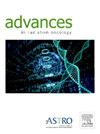Augsburg鼻咽涂布器的开发和验证:提高鼻路近距离治疗的疗效
IF 2.7
Q3 ONCOLOGY
引用次数: 0
摘要
目的:本研究对早期鼻咽癌(T1-T2期)的新型鼻近距离治疗装置——Augsburg鼻咽插管器(ANA)进行评价。ANA利用鼻腔解剖克服口腔涂抹器的局限性,优化肿瘤靶向,同时保留邻近组织,如软腭和口腔黏膜。方法和材料采用基于矢状位计算机层析成像的解剖测量和计算机辅助设计建模。通过非线性有限元分析、机械应力测试(包括欧拉屈曲测试)和位移测试(5 Hz、2 cm振幅、30 min振动)验证了结构的完整性。使用放射致色膜进行剂量测定,采用3%/ 3mm伽马分析标准,剂量计算遵循TG-43公式。根据机构尸检协议,在死后模型中评估插入可行性。结果ana(尼龙6/6导管)可承受30 mm的位移而无故障。模拟运动测试显示位置稳定性(<;1毫米位移)。剂量学达到了97.5%的伽玛及格率(临床可接受阈值:95%),与标准口腔涂布器(例如鹿特丹设计)相比,20mm曲率配置使软腭剂量减少了50%。死后插入在10分钟内完成,内窥镜确认定位精度在1mm以内。结论sana具有精确的定位,模拟生理运动下的机械稳定性(位移1mm),以及临床上显著的剂量节约(20mm曲率配置下软腭减少50%)。其鼻入路和解剖适应性使其成为口腔应用器的一个有前途的替代品。这些概念验证结果支持需要进行1/2期临床试验来评估患者的安全性和有效性。本文章由计算机程序翻译,如有差异,请以英文原文为准。
Development and Validation of the Augsburg Nasopharyngeal Applicator: Enhancing Efficacy in Nasal Route Brachytherapy
Purpose
This study evaluates the Augsburg Nasopharyngeal Applicator (ANA), a novel nasal brachytherapy device designed for early-stage nasopharyngeal carcinoma (T1–T2 stages). ANA leverages nasal anatomy to overcome limitations of oral applicators, optimizing tumor targeting while sparing adjacent tissues, such as the soft palate and oral mucosa.
Methods and Materials
ANA was developed using sagittal computed tomography-based anatomic measurements and computer-aided design modeling. Structural integrity was validated through nonlinear finite-element analysis, mechanical stress testing (including Euler buckling tests), and displacement testing (30 min vibration at 5 Hz with 2 cm amplitude). Dosimetry was verified using radiochromic film with 3%/3 mm gamma analysis criteria, following the TG-43 formalism for dose calculation. Insertion feasibility was assessed in a postmortem model under institutional autopsy protocols.
Results
ANA (with nylon 6/6 catheter) withstood displacements up to 30 mm without failure. Simulated motion tests demonstrated positional stability (<1 mm displacement). Dosimetry achieved a 97.5% gamma pass rate (clinical acceptability threshold: 95%), with the 20 mm curvature configuration reducing soft palate doses by >50% compared to standard oral applicators (eg, Rotterdam design). Postmortem insertion was completed in 10 min, with endoscopic confirmation of positioning accuracy within 1 mm.
Conclusions
ANA demonstrates precise positioning, mechanical stability under simulated physiologic motion (<1 mm displacement), and clinically significant dose sparing (>50% reduction to the soft palate with the 20 mm curvature configuration). Its nasal approach and anatomic adaptability position it as a promising alternative to oral applicators. These proof-of-concept findings support the need for phase 1/2 clinical trials to evaluate safety and efficacy in patients.
求助全文
通过发布文献求助,成功后即可免费获取论文全文。
去求助
来源期刊

Advances in Radiation Oncology
Medicine-Radiology, Nuclear Medicine and Imaging
CiteScore
4.60
自引率
4.30%
发文量
208
审稿时长
98 days
期刊介绍:
The purpose of Advances is to provide information for clinicians who use radiation therapy by publishing: Clinical trial reports and reanalyses. Basic science original reports. Manuscripts examining health services research, comparative and cost effectiveness research, and systematic reviews. Case reports documenting unusual problems and solutions. High quality multi and single institutional series, as well as other novel retrospective hypothesis generating series. Timely critical reviews on important topics in radiation oncology, such as side effects. Articles reporting the natural history of disease and patterns of failure, particularly as they relate to treatment volume delineation. Articles on safety and quality in radiation therapy. Essays on clinical experience. Articles on practice transformation in radiation oncology, in particular: Aspects of health policy that may impact the future practice of radiation oncology. How information technology, such as data analytics and systems innovations, will change radiation oncology practice. Articles on imaging as they relate to radiation therapy treatment.
 求助内容:
求助内容: 应助结果提醒方式:
应助结果提醒方式:


